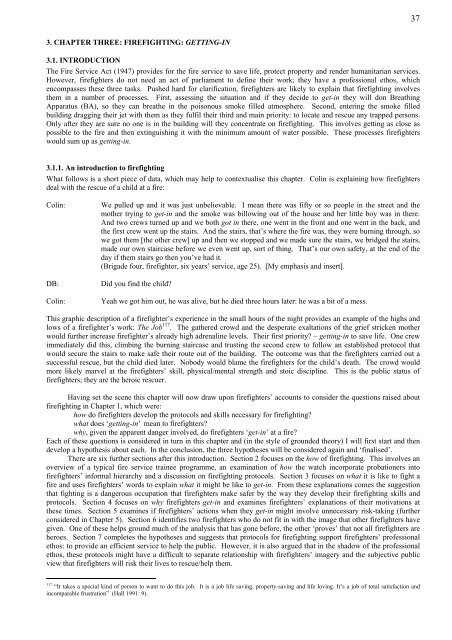One more last working class hero
One more last working class hero
One more last working class hero
You also want an ePaper? Increase the reach of your titles
YUMPU automatically turns print PDFs into web optimized ePapers that Google loves.
37<br />
3. CHAPTER THREE: FIREFIGHTING: GETTING-IN<br />
3.1. INTRODUCTION<br />
The Fire Service Act (1947) provides for the fire service to save life, protect property and render humanitarian services.<br />
However, firefighters do not need an act of parliament to define their work; they have a professional ethos, which<br />
encompasses these three tasks. Pushed hard for clarification, firefighters are likely to explain that firefighting involves<br />
them in a number of processes. First, assessing the situation and if they decide to get-in they will don Breathing<br />
Apparatus (BA), so they can breathe in the poisonous smoke filled atmosphere. Second, entering the smoke filled<br />
building dragging their jet with them as they fulfil their third and main priority: to locate and rescue any trapped persons.<br />
Only after they are sure no one is in the building will they concentrate on firefighting. This involves getting as close as<br />
possible to the fire and then extinguishing it with the minimum amount of water possible. These processes firefighters<br />
would sum up as getting-in.<br />
3.1.1. An introduction to firefighting<br />
What follows is a short piece of data, which may help to contextualise this chapter. Colin is explaining how firefighters<br />
deal with the rescue of a child at a fire:<br />
Colin:<br />
DB:<br />
Colin:<br />
We pulled up and it was just unbelievable. I mean there was fifty or so people in the street and the<br />
mother trying to get-in and the smoke was billowing out of the house and her little boy was in there.<br />
And two crews turned up and we both got in there, one went in the front and one went in the back, and<br />
the first crew went up the stairs. And the stairs, that’s where the fire was, they were burning through, so<br />
we got them [the other crew] up and then we stopped and we made sure the stairs, we bridged the stairs,<br />
made our own staircase before we even went up, sort of thing. That’s our own safety, at the end of the<br />
day if them stairs go then you’ve had it.<br />
(Brigade four, firefighter, six years’ service, age 25). [My emphasis and insert].<br />
Did you find the child?<br />
Yeah we got him out, he was alive, but he died three hours later: he was a bit of a mess.<br />
This graphic description of a firefighter’s experience in the small hours of the night provides an example of the highs and<br />
lows of a firefighter’s work: The Job 117 . The gathered crowd and the desperate exaltations of the grief stricken mother<br />
would further increase firefighter’s already high adrenaline levels. Their first priority? – getting-in to save life. <strong>One</strong> crew<br />
immediately did this, climbing the burning staircase and trusting the second crew to follow an established protocol that<br />
would secure the stairs to make safe their route out of the building. The outcome was that the firefighters carried out a<br />
successful rescue, but the child died later. Nobody would blame the firefighters for the child’s death. The crowd would<br />
<strong>more</strong> likely marvel at the firefighters’ skill, physical/mental strength and stoic discipline. This is the public status of<br />
firefighters; they are the <strong>hero</strong>ic rescuer.<br />
Having set the scene this chapter will now draw upon firefighters’ accounts to consider the questions raised about<br />
firefighting in Chapter 1, which were:<br />
how do firefighters develop the protocols and skills necessary for firefighting?<br />
what does ‘getting-in’ mean to firefighters?<br />
why, given the apparent danger involved, do firefighters ‘get-in’ at a fire?<br />
Each of these questions is considered in turn in this chapter and (in the style of grounded theory) I will first start and then<br />
develop a hypothesis about each. In the conclusion, the three hypotheses will be considered again and ‘finalised’.<br />
There are six further sections after this introduction. Section 2 focuses on the how of firefighting. This involves an<br />
overview of a typical fire service trainee programme, an examination of how the watch incorporate probationers into<br />
firefighters’ informal hierarchy and a discussion on firefighting protocols. Section 3 focuses on what it is like to fight a<br />
fire and uses firefighters’ words to explain what it might be like to get-in. From these explanations comes the suggestion<br />
that fighting is a dangerous occupation that firefighters make safer by the way they develop their firefighting skills and<br />
protocols. Section 4 focuses on why firefighters get-in and examines firefighters’ explanations of their motivations at<br />
these times. Section 5 examines if firefighters’ actions when they get-in might involve unnecessary risk-taking (further<br />
considered in Chapter 5). Section 6 identifies two firefighters who do not fit in with the image that other firefighters have<br />
given. <strong>One</strong> of these helps ground much of the analysis that has gone before, the other ‘proves’ that not all firefighters are<br />
<strong>hero</strong>es. Section 7 completes the hypotheses and suggests that protocols for firefighting support firefighters’ professional<br />
ethos: to provide an efficient service to help the public. However, it is also argued that in the shadow of the professional<br />
ethos, these protocols might have a difficult to separate relationship with firefighters’ imagery and the subjective public<br />
view that firefighters will risk their lives to rescue/help them.<br />
117 “It takes a special kind of person to want to do this job. It is a job life saving, property-saving and life loving. It’s a job of total satisfaction and<br />
incomparable frustration” (Hall 1991: 9).
















